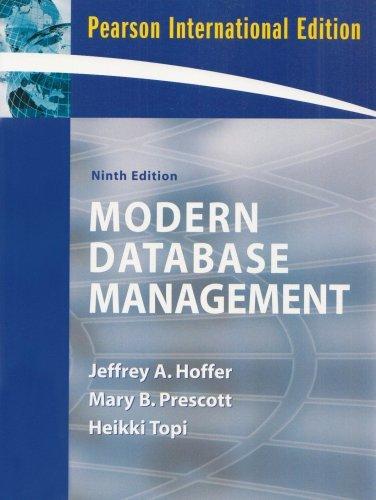Question
WHAT KIND OF MORE INFORMATION DO YOU WANT? THIS IS ALL THE INFORMATION I HAVE. module Main where import Test.HUnit import System.Exit -- *** Read
WHAT KIND OF MORE INFORMATION DO YOU WANT? THIS IS ALL THE INFORMATION I HAVE.
module Main where
import Test.HUnit import System.Exit
-- *** Read Chapters 8 and 16 ***
data Tree2 a b = Leaf2 a | Branch b (Tree2 a b) (Tree2 a b)
--------------- Tree2 objects tree2a :: Tree2 Int String -- to be used to test Problems 2 and 3 tree2a = Branch "A" (Branch "B" (Leaf2 1) (Leaf2 2)) (Leaf2 3)
tree2b :: Tree2 Int String -- to be used to test Problems 2 and 3 tree2b = Branch "+" (Branch "*" (Leaf2 3) (Branch "+" (Leaf2 4) (Leaf2 5))) (Branch "+" (Branch "*" (Leaf2 6) (Leaf2 7)) (Leaf2 8)) ---------------
-- Problem 2 (15 points) instance (Show a, Show b) => Show (Tree2 a b) where show t = undefined
-- Problem 3 (15 points) preorder :: (a -> c) -> (b -> c) -> Tree2 a b -> [c] -- 8 points preorder = undefined
inorder :: (a -> c) -> (b -> c) -> Tree2 a b -> [c] -- 7 points inorder = undefined
-- Problem 4 (10 + 15 = 25 points) -- Chapter 16, Exercise 6 (Modified)
data Tree = Leaf Int | Node Tree Tree
--------------- Tree objects tree1 :: Tree -- to be used to test Problem 4.1 tree1 = Node (Node (Node (Leaf 1) (Leaf 2)) (Leaf 3) ) (Node (Leaf 4) (Node (Leaf 5) (Leaf 6)) )
tree2 :: Tree -- to be used to test Problem 4.1 tree2 = Node (Leaf 7) (Node (Node (Leaf 8) (Leaf 9)) (Node (Leaf 10) (Leaf 11)) ) ---------------
-- Problem 4.1 (5 + 5 = 10 points) leaves :: Tree -> Int leaves = undefined
nodes :: Tree -> Int nodes = undefined
-- Problem 4.2 (Base case 5 points + inductive case 10 points = 15 points) {-- (Write your induction proof within this block comment.) Base case:
Inductive case: (Make sure that you state the induction hypothesis!)
--}
-- Problem 5 (40 points) Chapter 8, Exercise 9 data Expr = Val Int | Add Expr Expr | Mul Expr Expr
type Cont = [Op]
data Op = EVALA Expr | ADD Int | EVALM Expr | MUL Int
eval :: Expr -> Cont -> Int -- Give three definitions for eval. -- First two definitions, -- 1) for (Val n) and c as arguments and -- 2) for (Add x y) and c as arguments -- are already given in the text Section 8.7, but -- you need to modify the second definition slightly -- and give the third definition for (Mul x y) eval = undefined
exec :: Cont -> Int -> Int -- Give five definitions for exec, one for an empty list and -- one for each of the four constructors of the data type Op -- Some of these are already given in the text Section 8.7. exec = undefined
value :: Expr -> Int value e = eval e []
-- Following expressions are to test your eval and exec definitions -- (2 + 3) + 4 = 9 e1 = (Val 3) -- 3 e2 = (Add (Val 4) (Val 3)) -- 4 + 3 = 7 e3 = (Mul (Val 4) (Val 3)) -- 4 * 3 = 12 e4 = (Add (Add (Val 2) (Val 3)) (Val 4)) -- (2 + 3) + 4 = 9 e5 = (Mul (Mul (Val 2) (Val 3)) (Val 4)) -- (2 * 3) * 4 = 24 e6 = (Mul (Add (Val 2) (Val 3)) (Val 4)) -- (2 + 3) * 4 = 20 e7 = (Add (Mul (Val 2) (Val 3)) (Val 4)) -- (2 * 3) + 4 = 10 e8 = (Add (Mul (Val 2) (Val 3)) (Add (Val 4) (Val 5))) -- (2 * 3) + (4 + 5) = 15 e9 = (Mul (Add (Val 2) (Val 3)) (Add (Val 4) (Val 5))) -- (2 + 3) * (4 + 5) = 45 e10 = (Add (Mul (Add (Val 2) (Val 3)) (Mul (Val 4) (Val 5))) (Mul (Val 3) (Add (Val 4) (Val 7)))) -- ((2 + 3) * (4 * 5)) + (3 * (4 + 7)) = 133
myTestList = TestList [ "preorder 1" ~: (concat (preorder show id tree2a)) ~=? "AB123" , "inorder 1" ~: (concat (inorder show id tree2a)) ~=? "1B2A3" , "preorder 2" ~: (concat (preorder show id tree2b)) ~=? "+*3+45+*678" , "inorder 2" ~: (concat (inorder show id tree2b)) ~=? "3*4+5+6*7+8" , "leaves 1" ~: leaves tree1 ~=? 6 , "leaves 2" ~: leaves tree2 ~=? 5 , "nodes 1" ~: nodes tree1 ~=? 5 , "nodes 1" ~: nodes tree2 ~=? 4
, "value 1" ~: value e1 ~=? 3 , "value 2" ~: value e2 ~=? 7 , "value 3" ~: value e3 ~=? 12 , "value 4" ~: value e4 ~=? 9 , "value 5" ~: value e5 ~=? 24 , "value 6" ~: value e6 ~=? 20 , "value 7" ~: value e7 ~=? 10 , "value 8" ~: value e8 ~=? 15 , "value 9" ~: value e9 ~=? 45 , "value 10" ~: value e10 ~=? 133 ]
main = do c 0 = ExitFailure 2 | errs > 0 = ExitFailure 1 | otherwise = ExitSuccess
Step by Step Solution
There are 3 Steps involved in it
Step: 1

Get Instant Access to Expert-Tailored Solutions
See step-by-step solutions with expert insights and AI powered tools for academic success
Step: 2

Step: 3

Ace Your Homework with AI
Get the answers you need in no time with our AI-driven, step-by-step assistance
Get Started


